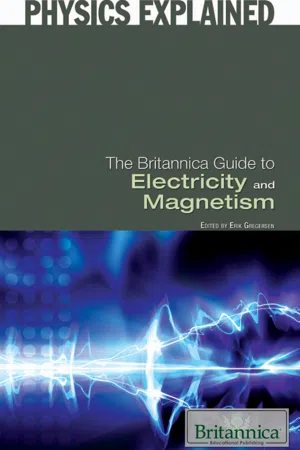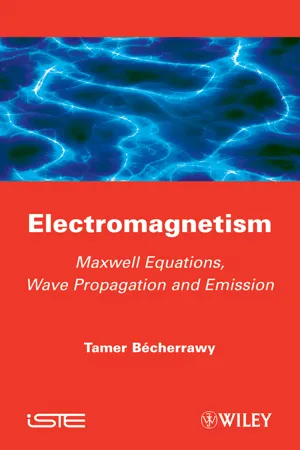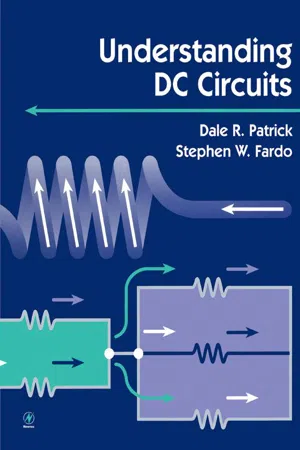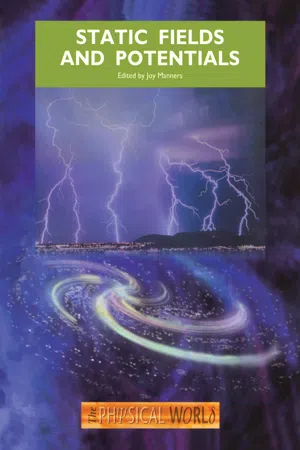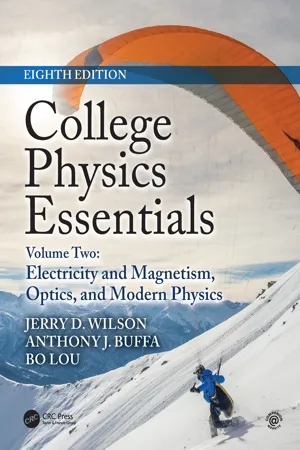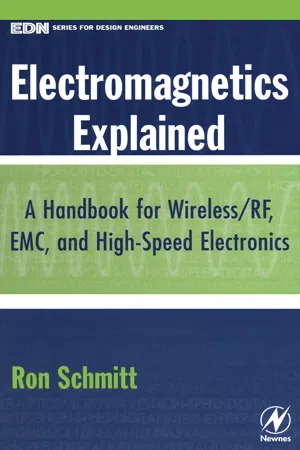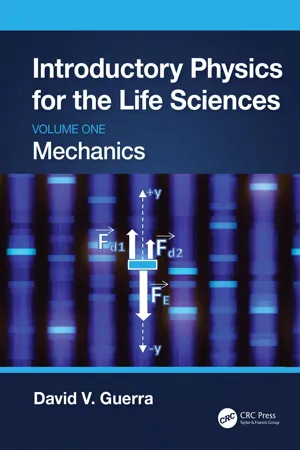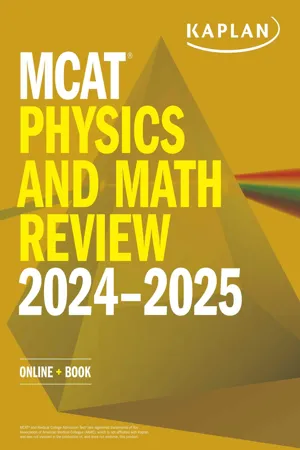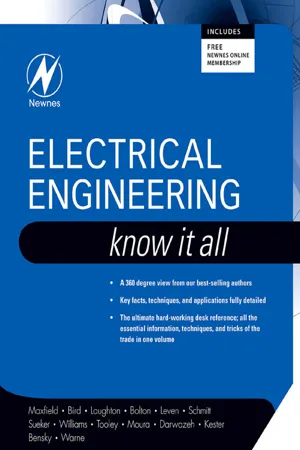Physics
Magnetism
Magnetism is a fundamental force that causes certain materials to attract or repel each other. It is generated by the movement of electric charges and is characterized by magnetic fields. Magnets have two poles, north and south, and like poles repel while opposite poles attract. Magnetism plays a crucial role in various technologies, including electric motors, generators, and magnetic storage devices.
Written by Perlego with AI-assistance
Related key terms
Related key terms
1 of 4
Related key terms
1 of 3
10 Key excerpts on "Magnetism"
- Britannica Educational Publishing, Erik Gregersen(Authors)
- 2010(Publication Date)
- Britannica Educational Publishing(Publisher)
CHAPTER 4 MAGNETISMM agnetism is a phenomenon associated with the motion of electric charges. This motion can take many forms. It can be an electric current in a conductor or charged particles moving through space, or it can be the motion of an electron in atomic orbit. Magnetism is also associated with elementary particles, such as the electron, that have a property called spin.FUNDAMENTALS
Basic to Magnetism are magnetic fields and their effects on matter, as, for instance, the deflection of moving charges and torques on other magnetic objects. Evidence for the presence of a magnetic field is the magnetic force on charges moving in that field; the force is at right angles to both the field and the velocity of the charge. This force deflects the particles without changing their speed. The deflection can be observed in the electron beam of a television tube when a permanent magnet is brought near the tube. A more familiar example is the torque on a compass needle that acts to align the needle with the magnetic field of Earth. The needle is a thin piece of iron that has been magnetized—i.e., a small bar magnet. One end of the magnet is called a north pole and the other end a south pole. The force between a north and a south pole is attractive, whereas the force between like poles is repulsive. The magnetic field is sometimes referred to as magnetic induction or magnetic flux density; it is always symbolized by B . Magnetic fields are measured in units of tesla (T). (Another unit of measure commonly used for B is the gauss, though it is no longer considered a standard unit. One gauss equals 10−4 tesla.)A fundamental property of a magnetic field is that its flux through any closed surface vanishes. (A closed surface is one that completely surrounds a volume.) This is expressed mathematically by div B = 0 and can be understood physically in terms of the field lines representing B- eBook - ePub
Electromagnetism
Maxwell Equations, Wave Propagation and Emission
- Tamer Becherrawy(Author)
- 2013(Publication Date)
- Wiley-ISTE(Publisher)
Chapter 7Magnetism in Matter
Before the discovery of the magnetic effects of electric current and charges, the understanding of Magnetism pertained to permanent magnets. Even today, some of the magnetic properties of matter remain little understood and other properties remain to be explored. This does not prevent Magnetism from underlying many applications, ranging from the magnetic compass to measurement instruments, electric generators and motors, magnetic tapes for sound and video recording and for computer data storage, magnetic levitation, etc. The purpose of this chapter is to introduce some basic elements of Magnetism in matter.7.1. Types of Magnetism
Some materials, said to be ferromagnetic , become magnetized if they are exposed to a magnetic field and they remain permanently magnetized if the magnetic field is removed. A magnetized body is equivalent to a magnetic moment M in a characteristic direction SN . An external magnetic field acts on this body and orients it in such a way that the field B enters the body at S and leaves it at N (Figure 7.1a ). Particularly, in the Earth's magnetic field, N points approximately toward the geographic North and S toward the South (Figure 7.1b ). However, contrary to the electric charges, which constitute an electric dipole, the “magnetic poles” cannot be separated and the concept of magnetic pole is simply an analogy with electric charges. Similar to dielectrics, which polarize if they are placed in an electric field, all materials become magnetized to some extent if they are submitted to the magnetic field B of an electric current or another magnetized body. Some materials (such as aluminum, chrome, platinum, etc.) acquire a magnetic moment in the direction of B , they are said to be paramagnetic . Other materials (such as silver, gold, copper, mercury, lead, etc.) acquire a magnetic moment in the opposite direction to B , they are said to be diamagnetic . A magnetized body produces its own magnetic field, which leaves the body near N and enters the body near S (Figure 7.1c ). - eBook - ePub
- Dale Patrick, Stephen Fardo(Authors)
- 1999(Publication Date)
- Newnes(Publisher)
Unit 4Magnetism and ElectroMagnetism
Magnetism has been studied for many years. Some metals in their natural state attract small pieces of iron. This property is called Magnetism . Materials that have this ability are called natural magnets . The first magnets used were called lodestones . Now artificial magnets are made in many different strengths, sizes, and shapes. Magnetism is important because it is used in electric motors, generators, transformers, relays, and many other electric devices. The earth itself has a magnetic field like a large magnet.ElectroMagnetism is Magnetism that is brought about by electric current flow. Many electric machines operate because of electroMagnetism. This unit deals with Magnetism, electroMagnetism, and some important applications.UNIT OBJECTIVES Upon completion of this unit, you will be able to do the following:1. Define the various terms relative to Magnetism.2. Explain the operation of various magnetic devices.3. State Faraday′s law for electromagnetic induction.4. List three factors that affect the strength of electromagnets.5. Apply the left-hand rule for polarity.6. Describe the construction of a relay and solenoid.7. Define the terms residual Magnetism, permeability, retentivity, magnetic saturation, and magnetizing force.8. Describe the domain theory of MagnetismImportant Terms
In this unit you will study Magnetism and electroMagnetism. There are many important applications of Magnetism and electroMagnetism. The terms that follow will help you define some of the specifics involved in the study of Magnetism and electroMagnetism. - eBook - ePub
- Joy Manners(Author)
- 2020(Publication Date)
- CRC Press(Publisher)
Chapter 4 Magnetic fields and the Lorentz force law DOI: 10.4324/9780429187797-51 The magic of Magnetism
Even experienced physicists can still be amazed by the phenomenon of Magnetism. Holding two bar magnets and feeling their repulsion or attraction is a reminder of what physics is for. It allows us to describe succinctly what seems at first indescribable, and it allows us to connect what appear to be unconnected phenomena. In particular, in this chapter, we will make the connection between Magnetism and electric currents. This link provides the basis of the subject known as electroMagnetism.Figure 4.1 demonstrates a purely magnetic effect. It shows several paper clips adhering to a bar magnet. It is a simple demonstration, and, as such, might be treated with a certain condescension. However, there are many reasons why this would be an inappropriate reaction, and several lessons to be learned.- The first is that it is hard to devise any explanation of this phenomenon that does not involve the concept of afield. The influence of the magnet extends into space away from itself and does not involve the passage of any material particles from the magnet to the paper clips.
- The second is that although the field is not a material object in itself, its sources are material and it can only be detected by its effect on matter. Thus, our determination of the properties of a field is, in a sense, always second-hand.
- The third lesson to draw from this demonstration is one of awe. Einstein was in his late sixties when he wrote:
I experienced a miracle … as a child of four or five when my father showed me a compass … [I realized] there had to be something behind objects that lay deeply hidden.’
The topics covered in this chapter range from the forces between current-carrying wires through to the discovery of the radiation belts surrounding the Earth. However, throughout our exploration of these subjects, one concept will figure prominently — the idea of a magnetic field. - eBook - ePub
College Physics Essentials, Eighth Edition
Electricity and Magnetism, Optics, Modern Physics (Volume Two)
- Jerry D. Wilson, Anthony J. Buffa, Bo Lou(Authors)
- 2019(Publication Date)
- CRC Press(Publisher)
When thinking about Magnetism, most people tend to envision an attractive force, because it is well known that certain materials can be picked up with a magnet. For example, paper clips are attracted to a magnet, and you have probably seen souvenir magnets that can stick to a refrigerator. It is less likely, however, that a repulsive magnetic force would come to mind. But there are repulsive magnetic forces, and they can be as useful as attractive ones. In this regard, the chapter-opening photo shows an interesting example. At first glance, the vehicle looks like an ordinary train. But where are its wheels? In fact, it isn’t a conventional train, but a high-speed, magnetically levitated one. It doesn’t physically touch the rails; rather, it “floats” above them, supported by repulsive forces produced by powerful magnets. The advantages are obvious: with no wheels, there is no rolling friction and few moving parts.But where do these magnetic forces come from? For centuries, the properties of magnets were attributed to the supernatural. The original “natural” magnets, called lodestones , were found in the ancient Greek province of Magnesia. Magnetism was later discovered to be associated with electricity in an area of study that is now called electroMagnetism . The forces described by electroMagnetism are routinely used in such applications as motors and generators.It is now known that electricity and Magnetism are actually different manifestations of the same force. However, initially it is instructive to consider them individually. 19.1 Permanent Magnets, Magnetic Poles, and Magnetic FieldOne of the features of a common bar magnet is that it has two “centers of force,” called poles , near each end (▼ Figure 19.1 ). To avoid confusion with the ± designation used for electric charge, magnetic poles are instead labeled north (N) and south (S). This terminology stems from the early use of the magnetic compass to determine direction. The north pole of a compass needle was historically defined as the north-seeking pole – that is, the end that points north on the Earth. The other end is south-seeking – that is, a south pole. A confusing result of this definition can result because the north pole of a compass needle is attracted to the Earth’s north polar region (that is, geographic north), which means that the geographic north area is actually a south magnetic pole. (See Section 19.8 for more details about the Earth’s magnetic field.)▲ Figure 19.1 Bar magnet The iron filings (acting as little compass needles) indicate the poles, or centers of force, of a common bar magnet. Determination of the type of pole at each end is found using a compass (see Figure 19.3 - eBook - ePub
Electromagnetics Explained
A Handbook for Wireless/ RF, EMC, and High-Speed Electronics
- Ron Schmitt(Author)
- 2002(Publication Date)
- Newnes(Publisher)
Chapter 6 , you will learn more about the vector potential when we discuss quantum physics.MAGNETIC MATERIALS
DiaMagnetism
In Chapter 2 , you learned that different materials behave differently in electric fields. You learned about conductors and dielectrics. Electric fields induce reactions in materials. In conductors, charges separate and nullify the field within the conductor. In dielectrics, atoms or molecules rotate or polarize to reduce the field. Magnetic fields also induce reactions in materials. However, since there are no magnet charges, there is no such thing as a “magnetic conductor.” All materials react to magnetic fields similarly to the way dielectrics react to electric fields. To be precise, magnetic materials usually interact with an external magnetic field via dipole rotations at the atomic level. For a simple explanation, you can think of an atom as a dense positive nucleus with light electrons orbiting the nucleus, an arrangement reminiscent of the planets orbiting the sun in the solar system. Another similar situation is that of a person swinging a ball at the end of a string. In each situation, the object is held in orbit by a force that points toward the orbit center. This type of force is called a centripetal force. The force is conveyed by electricity, gravity, or the string tension, respectively, for the three situations. Referring to Figure 3.17 and using the cross product right hand rule, you find that the force due to the external magnetic field points inward, adding to the centripetal force. The increase in speed increases the electron’s magnetic field, which is opposite to the external field. The net effect is that the orbiting electron tends to cancel part of the external field. Just as the free electron rotates in opposition to a magnetic field, the orbiting electron changes to oppose the magnetic field. This effect is called diaMagnetism - David V. Guerra(Author)
- 2023(Publication Date)
- CRC Press(Publisher)
6 Magnetic Forces
DOI: 10.1201/9781003308065-66.1 Introduction
If you have ever used a magnet to pick up a paper clip, you have experienced the magnetic force. This force of nature is normally combined with the electric force from the previous chapter into one force of nature called the electromagnetic force. As you read through this chapter, it will become apparent that both these forces, electric and magnetic, are associated with the electrical charge of an object. Therefore, in this chapter, the magnetic force will be computed with the quantities of electrical current and electric charge. Examples of each type of force calculation will be presented and the definition of the magnetic field will be established. The connection between the analyses employed in the study of torques will also be presented to complement and spiral with the sequence of analysis established in the first three chapters of the text.- Chapter question: An MRI (Magnetic Resonance Imaging) is a sophisticated piece of medical machinery that allows doctors to see soft tissue in a way that X-ray cannot. The word magnetic is part of the acronym by which these devices are known, so what is the role of the magnetic in MRI? This question will be answered at the end of this chapter after the concepts of magnetic forces and magnetic fields are studied.
6.2 Magnets
The simplest place to start a discussion about magnetic phenomena is a bar magnet, which is most likely some composite of iron, cobalt, and nickel that has been magnetized by placing it near another strong magnet. These metals that hold their magnetic field are called ferromagnets. If a bar magnet, like the one in Figure 6.1 , is split in half, each half will have a north and a south pole.FIGURE 6.1 Magnet poles (N’s and S’s) cannot be separated.If each half is split over and over again, each piece will still have both poles. In fact, atoms, electrons, protons, and neutrons have both a north and a south pole. If we split a magnet in half and then flip one of the magnets, the like poles will face each other, and the magnets will repel. See Figure 6.1- No longer available |Learn more
MCAT Physics and Math Review 2024-2025
Online + Book
- (Author)
- 2023(Publication Date)
- Kaplan Test Prep(Publisher)
Magnetic fields may be set up by the movement of individual charges, such as an electron moving through space; by the mass movement of charge in the form of a current though a conductive material, such as a copper wire; or by permanent magnets. The SI unit for magnetic field strength is the tesla (T), where 1 T = 1 N ⋅ s m ⋅ C. The size of the tesla unit is quite large, so small magnetic fields are sometimes measured in gauss, where 1 T = 10 4 gauss. KEY CONCEPT Any moving charge, whether a single electron traveling through space or a current through a conductive material, creates a magnetic field. The SI unit for magnetic field strength is the tesla (T). All materials can be classified as diamagnetic, paramagnetic, or ferromagnetic. Diamagnetic materials are made of atoms with no unpaired electrons and that have no net magnetic field. These materials are slightly repelled by a magnet and so can be called weakly antimagnetic. Diamagnetic materials include common materials that you wouldn’t expect to get stuck to a magnet: wood, plastics, water, glass, and skin, just to name a few. The atoms of both paramagnetic and ferromagnetic materials have unpaired electrons, so these atoms do have a net magnetic dipole moment, but the atoms in these materials are usually randomly oriented so that the material itself creates no net magnetic field. Paramagnetic materials will become weakly magnetized in the presence of an external magnetic field, aligning the magnetic dipoles of the material with the external field. Upon removal of the external field, the thermal energy of the individual atoms will cause the individual magnetic dipoles to reorient randomly. Some paramagnetic materials include aluminum, copper, and gold. Ferromagnetic materials, like paramagnetic materials, have unpaired electrons and permanent atomic magnetic dipoles that are normally oriented randomly so that the material has no net magnetic dipole - eBook - ePub
Life and Matter
A Criticism of Professor Haeckel's "Riddle of the Universe"
- Lodge, Oliver, Sir(Authors)
- 2008(Publication Date)
- Perlego(Publisher)
But within the nineteenth century a fresh process of magnetisation has been discovered, and this new or electrical process is no longer obviously dependent on the existence of antecedent Magnetism, but seems at first sight to be a property freshly or spontaneously generated, as it were. The process was discovered as the result of setting electricity into motion. So long as electricity was studied in its condition at rest on charged conductors, as in the old science of electrostatics or frictional electricity, it possessed no magnetic properties whatever, nor did it encroach on the magnetic domain: only vague similarities in the phenomena of attraction and repulsion aroused attention. But directly electricity was set in motion, constituting what is called an electric current, magnetic lines of force instantly sprang into being, without the presence of any steel or iron; and in twenty years they were recognised. These electrically generated lines of force are similar to those previously known, but they need no matter to sustain them. They need matter to display them, but they themselves exist equally well in perfect vacuum.How did they manage to spring into being? Can it be said that they too had existed previously in some dormant condition in the ether of space? That they too were closed loops opened out, and their existence thus displayed, by the electric current?That is an assertion which might reasonably be made: it is not the only way of regarding the matter, however, and the mode in which a magnetic field originates round the path of a moving charge—being generated during the acceleration-period by a pulse of radiation which travels with the speed of light, being maintained during the steady-motion period by a sort of inertia as if in accordance with the first law of motion, and being destroyed only by a return pulse of re-radiation during a retardation-period when the moving charge is stopped or diverted or reversed—all this can hardly be fully explained until the intimate nature of an electric charge has been more fully worked out; and the subject now trenches too nearly on the more advanced parts of Physics to be useful any longer as an analogue for general readers.Indeed it must be recollected that no analogy will bear pressing too far. All that we are concerned to show is that known magnetic behaviour exhibits a very fair analogy to some aspects of that still more mysterious entity which we call "life"; and if anyone should assert that all Magnetism was pre-existent in some ethereal condition, that it would never go out of essential existence, but that it could be brought into relation with the world of matter by certain acts,—that while there it could operate in a certain way, controlling the motion of bodies, interacting with forms of energy, producing sundry effects for a time, and then disappearing from our ken to the immaterial region whence it came,—he would be saying what no physicist would think it worth while to object to, what many indeed might agree with. - eBook - ePub
- Clive Maxfield, John Bird, Tim Williams, Walt Kester, Dan Bensky(Authors)
- 2011(Publication Date)
- Newnes(Publisher)
Magnetic fields also induce reactions in materials. However, since there are no magnet charges, there is no such thing as a “magnetic conductor.” All materials react to magnetic fields similarly to the way dielectrics react to electric fields. To be precise, magnetic materials usually interact with an external magnetic field via dipole rotations at the atomic level. For a simple explanation, you can think of an atom as a dense positive nucleus with light electrons orbiting the nucleus, an arrangement reminiscent of the planets orbiting the sun in the solar system. Another similar situation is that of a person swinging a ball at the end of a string. In each situation, the object is held in orbit by a force that points toward the orbit center. This type of force is called a centripetal force. The force is conveyed by electricity, gravity, or the string tension, respectively, for the three situations. Referring to Figure 21.17 and using the cross product right hand rule, you find that the force due to the external magnetic field points inward, adding to the centripetal force. The increase in speed increases the electron’s magnetic field, which is opposite to the external field. The net effect is that the orbiting electron tends to cancel part of the external field. Just as the free electron rotates in opposition to a magnetic field, the orbiting electron changes to oppose the magnetic field. This effect is called diaMagnetism and is just like that of dielectrics, where the dielectrics tend to reduce the applied electric field. The major difference here is that diaMagnetism is an extremely weak effect. Even though all materials exhibit diaMagnetism, the effect is so weak that you can usually ignore it. This explains the commonly known fact that most materials are not affected by magnets. Figure 21.17 (a) A circulating electron in which the magnetic moment points upward; (b) Applying a downward magnetic field increases the upward moment of the electron
Index pages curate the most relevant extracts from our library of academic textbooks. They’ve been created using an in-house natural language model (NLM), each adding context and meaning to key research topics.
Explore more topic indexes
Explore more topic indexes
1 of 6
Explore more topic indexes
1 of 4
